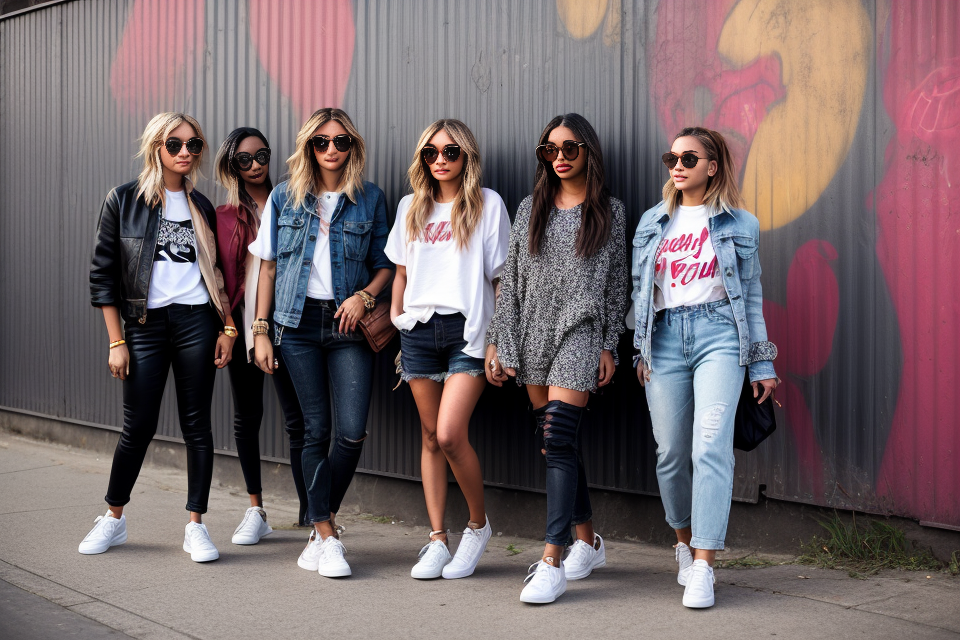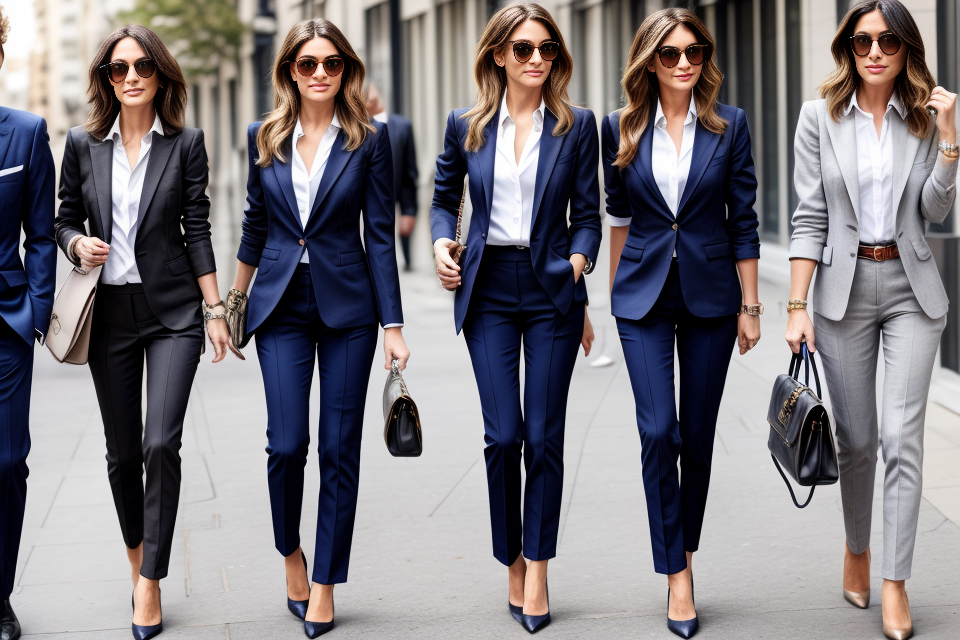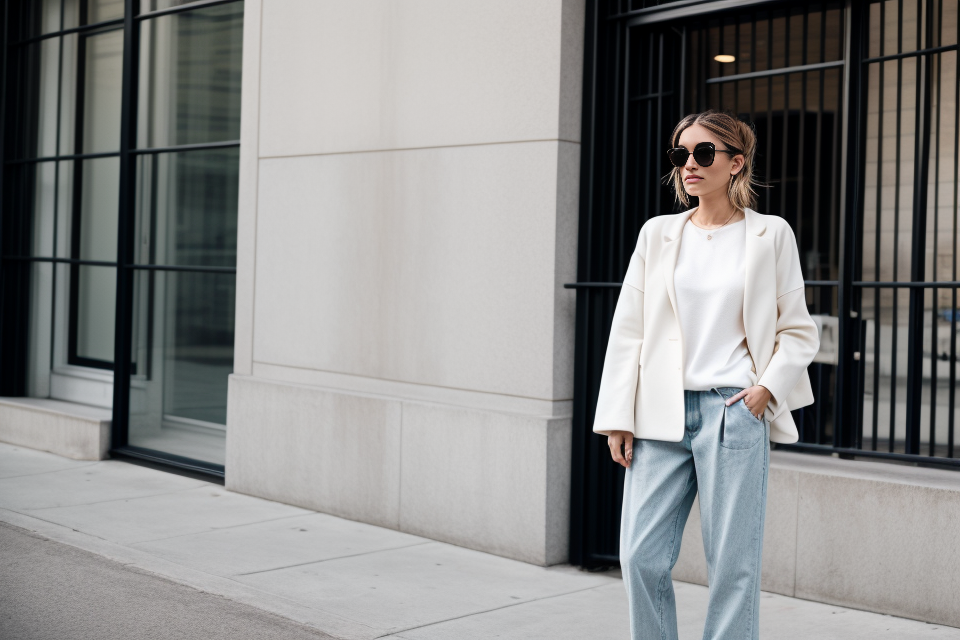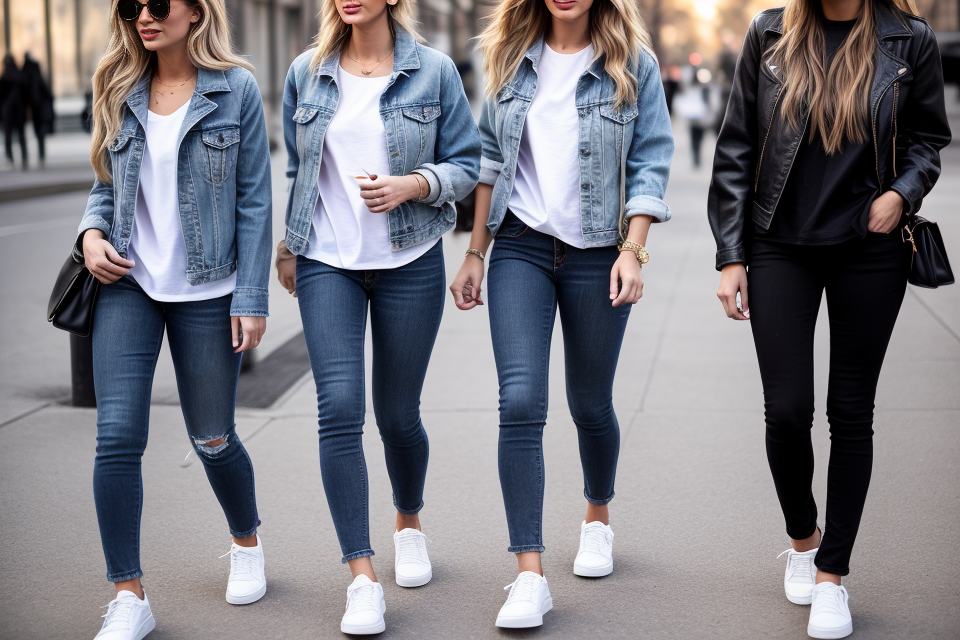
Fashion has undergone a dramatic transformation in recent years, with casual styles becoming the norm. Gone are the days of formal attire, and in its place, we see a rise in the popularity of comfortable, relaxed clothing. This shift in fashion can be attributed to a number of factors, including changing social attitudes, the influence of technology, and the rise of streetwear. In this article, we will explore the reasons behind this trend, and why fashion has embraced casualness.
The Shift from Formality to Comfort
The Rise of Athleisure
The Popularity of Activewear
In recent years, activewear has gained immense popularity among consumers. This can be attributed to the growing trend of health and wellness, as well as the rise of athleisure as a fashion statement. People are increasingly choosing to wear comfortable clothing that they can move in, whether they are working out or just going about their daily lives. The demand for activewear has skyrocketed, with many fashion brands introducing their own lines of activewear, including Nike, Adidas, and Lululemon.
The Blurring of Fashion and Sportswear
Another factor contributing to the rise of athleisure is the blurring of lines between fashion and sportswear. Designers are now incorporating athletic elements into their fashion collections, creating a more casual and comfortable aesthetic. This has led to the rise of fashion-forward athletic wear, such as leggings, joggers, and oversized sweatshirts, which can be worn both during workouts and as part of a stylish everyday outfit. As a result, the distinction between sportswear and fashion has become increasingly blurred, with many clothing items now being classified as both.
The Impact of Social Media
Social media has also played a significant role in the rise of athleisure. Platforms such as Instagram and TikTok have popularized the trend, with influencers and celebrities often seen wearing athleisure clothing. This has created a desire among consumers to emulate this look, leading to an increase in demand for athleisure wear. Furthermore, social media has made it easier for people to stay up-to-date with the latest fashion trends, making athleisure a staple in many wardrobes.
Overall, the rise of athleisure is a reflection of the changing attitudes towards fashion and comfort. As people prioritize comfort and practicality over formality and tradition, athleisure has emerged as a popular alternative to formal wear. With its combination of style and functionality, it is likely to remain a dominant trend in the fashion industry for years to come.
The Influence of Street Style
The Impact of Urban Culture
- The urbanization of society has led to a shift in the way people dress, with the rise of casual clothing reflecting the desire for comfort and practicality in daily life.
- The influence of urban culture has played a significant role in this shift, with the fusion of different styles and influences creating a unique aesthetic that is both functional and fashionable.
The Emergence of Streetwear as a Fashion Trend
- Streetwear, a style of clothing that originated in urban culture, has become a dominant force in the fashion industry, with its influence extending beyond the streets and into high-end fashion.
- The emergence of streetwear as a fashion trend can be attributed to its ability to bridge the gap between comfort and style, offering a unique blend of functionality and fashion-forward design.
- Streetwear has also played a significant role in the democratization of fashion, with its accessibility and affordability making it accessible to a wider audience.
- This shift towards casualness in fashion has been driven by a number of factors, including changes in societal values, the rise of social media, and the increasing influence of urban culture.
- The embracing of casualness in fashion has also been influenced by the desire for self-expression and individuality, with the rise of streetwear and other casual styles offering a platform for individuals to express their unique style and identity.
The Psychology Behind Casual Fashion
The Desire for Comfort
The Comfort Factor
In today’s fast-paced world, people are constantly seeking comfort in their clothing choices. The comfort factor has become a major driving force behind the embrace of casual fashion. With busy lifestyles and increasing work demands, individuals seek clothing that is easy to wear, comfortable, and versatile. The desire for comfort has led to the popularity of relaxed fits, breathable fabrics, and soft materials that offer a sense of ease and relaxation.
The Psychology of Comfort Clothing
Comfort clothing is not just about physical comfort; it also has psychological implications. Research has shown that individuals who wear comfortable clothing experience lower levels of stress and anxiety. Comfort clothing provides a sense of security and familiarity, which can reduce feelings of insecurity and self-consciousness. Additionally, comfortable clothing can enhance feelings of self-esteem and confidence, leading to improved mood and overall well-being. The psychological benefits of comfort clothing have made it a sought-after feature in the fashion industry, as people prioritize comfort over style in their daily lives.
The Impact of Social Media
Social media has revolutionized the way people interact with fashion, making it more accessible and relatable than ever before. Here are some of the ways social media has impacted the fashion industry:
The Influence of Instagram and TikTok
Instagram and TikTok have become powerful platforms for fashion influencers to showcase their style and share their fashion choices with their followers. These platforms have made it easier for people to discover new trends and brands, and have also made it easier for brands to reach a wider audience.
For example, the #OOTD (Outfit of the Day) hashtag on Instagram has become a popular way for people to share their outfits and get feedback from others. Similarly, TikTok has made it easier for people to discover new fashion trends and brands through videos.
The Role of Influencers in Casual Fashion
Influencers have played a significant role in the rise of casual fashion. They have helped to make fashion more accessible and relatable by sharing their own fashion choices and showing how they wear casual clothes in their everyday lives.
In addition, influencers have also helped to democratize fashion by making it easier for people to discover new brands and designers. They have also helped to break down the barriers between fashion and other areas of culture, such as music and art.
Overall, social media has had a profound impact on the fashion industry, making it more accessible and relatable than ever before. It has also helped to create a more diverse and inclusive fashion culture, where everyone can participate and share their unique style.
The Environmental and Ethical Aspects of Casual Fashion
The Sustainability Movement
The sustainability movement has been a significant driving force behind the growing acceptance of casual fashion. In recent years, consumers have become increasingly conscious of the environmental impact of their clothing choices. The fashion industry is one of the largest polluters in the world, and fast fashion, in particular, has been criticized for its wasteful and unsustainable practices.
As a result, many consumers are looking for more eco-friendly alternatives, and the casual fashion trend has emerged as a response to this demand. Eco-friendly fashion refers to clothing made from sustainable materials and produced using environmentally friendly processes. This includes clothing made from organic cotton, recycled materials, and other sustainable fabrics.
The growth of slow fashion is another aspect of the sustainability movement that has influenced the embrace of casual fashion. Slow fashion is a movement that emphasizes quality over quantity, and encourages consumers to buy fewer, better-made garments that will last longer. This approach is in contrast to fast fashion, which encourages consumers to buy more clothes, more often.
Slow fashion advocates for sustainable and ethical production practices, and emphasizes the importance of transparency and accountability in the supply chain. This includes ensuring that garment workers are paid a living wage, and that materials are sourced ethically and sustainably.
In conclusion, the sustainability movement has played a significant role in the growing acceptance of casual fashion. As consumers become more conscious of the environmental impact of their clothing choices, they are seeking out more eco-friendly and sustainable alternatives. The casual fashion trend has emerged as a response to this demand, and is becoming increasingly popular as a more sustainable and ethical alternative to fast fashion.
The Ethics of Fast Fashion
The Impact of Fast Fashion on the Environment
Fast fashion, a term used to describe the rapid production of low-cost clothing, has come under scrutiny for its environmental impact. This industry, which thrives on producing trendy items at an affordable price, has resulted in excessive waste and pollution.
- Waste: With fast fashion’s focus on rapid production and constant new arrivals, there is a significant amount of textile waste generated. The average person now buys 60% more items than 15 years ago, and many of these items are never worn even once. The excess fabric and garments end up in landfills, where they take years to decompose and release harmful chemicals into the soil and groundwater.
- Pollution: The manufacturing process of fast fashion is also detrimental to the environment. Textile mills use large amounts of water, energy, and chemicals, such as formaldehyde and bleach, to produce clothes. These chemicals often end up in rivers and oceans, causing damage to marine life and ecosystems.
The Labor Conditions in the Fast Fashion Industry
Fast fashion’s rapid production timelines and low-cost models often result in exploitative labor conditions. Many workers in the fast fashion industry face long working hours, low wages, and poor working conditions.
- Low Wages: The fast fashion industry has been criticized for paying workers in developing countries very low wages. This results in workers struggling to make ends meet, with some even resorting to living in poverty.
- Poor Working Conditions: Workers in the fast fashion industry also face long working hours, poor working conditions, and a lack of job security. Many workers are required to work in cramped and poorly ventilated spaces, leading to health problems and accidents.
In summary, the ethics of fast fashion are concerning, with its environmental impact and exploitative labor conditions. The rapid production and low-cost models employed by the fast fashion industry have serious consequences for the environment and the workers involved in its production.
The Future of Casual Fashion
The Post-Pandemic Wardrobe
The pandemic has indelibly marked the fashion industry, forcing it to adapt to new realities and expectations. As the world slowly emerges from the crisis, fashion has embraced casualness like never before. The post-pandemic wardrobe represents a new era in fashion, characterized by versatility, functionality, and comfort.
The Lasting Impact of the Pandemic on Fashion
The pandemic has drastically altered the way people live, work, and socialize. Consequently, fashion has had to adapt to these changes, prioritizing comfort and practicality over formal attire. The pandemic has also accelerated the shift towards online shopping, making the global market more accessible and increasing the demand for casual wear.
The Emphasis on Versatility and Functionality
The post-pandemic wardrobe is all about versatility and functionality. With many people working from home, the need for a wardrobe that can transition seamlessly from work to leisure has become crucial. As a result, clothing items that can be dressed up or down for different occasions are highly sought after. Additionally, functionality has become a significant factor in fashion, with clothing items designed to be practical and long-lasting. The post-pandemic wardrobe emphasizes quality over quantity, with a focus on investment pieces that can be worn for years to come.
The Continued Evolution of Casual Fashion
Casual fashion has come a long way since its inception in the 1960s, and it continues to evolve with each passing season. One of the most significant factors driving this evolution is the changing preferences of consumers. Today’s shoppers are looking for clothes that are not only stylish but also comfortable and versatile. They want garments that can be easily mixed and matched to create a variety of looks, and that can be worn on different occasions.
Another factor contributing to the continued evolution of casual fashion is the rise of new technologies. Advances in fabric science and manufacturing have enabled designers to create fabrics that are soft, breathable, and durable. These innovations have allowed them to push the boundaries of what is possible in terms of style and design.
Additionally, the continued evolution of casual fashion is being driven by changes in social and cultural norms. As gender norms continue to blur, fashion is reflecting this shift by embracing a more androgynous aesthetic. Designers are increasingly blurring the lines between menswear and womenswear, creating clothes that can be worn by anyone, regardless of gender.
Furthermore, the rise of emerging fashion capitals is also playing a role in the continued evolution of casual fashion. Cities like Seoul, Tokyo, and Lagos are producing some of the most exciting and innovative designs, pushing the boundaries of what is possible in terms of style and aesthetics. These cities are home to some of the most diverse and vibrant fashion scenes in the world, and they are providing a source of inspiration for designers and consumers alike.
Overall, the continued evolution of casual fashion is being driven by a range of factors, including changing consumer preferences, advances in technology, shifts in social and cultural norms, and the rise of emerging fashion capitals. As the fashion industry continues to evolve, it will be interesting to see how these trends play out and what new developments will emerge in the years to come.
The Adaptation of Traditional Luxury Brands
The Embracing of Casualness by Luxury Brands
Luxury brands, once synonymous with formal wear and traditional fashion, have begun to embrace casualness in their designs. This shift can be attributed to several factors, including the changing preferences of consumers and the desire of luxury brands to appeal to a wider audience.
- Consumer preferences: The rise of streetwear and athleisure has led to a significant shift in consumer preferences. Today’s consumers are more interested in comfortable and functional clothing that can be worn in a variety of settings, rather than formal wear that is only suitable for special occasions.
- The influence of social media: Social media has played a significant role in the rise of casual fashion. Platforms like Instagram and TikTok have made it easier for consumers to discover new trends and styles, and have also given rise to influencers who promote casual, streetwear-inspired fashion.
The Blurring of the Lines Between Luxury and Streetwear
As luxury brands have embraced casualness, the lines between luxury and streetwear have become increasingly blurred. Luxury brands are now incorporating elements of streetwear into their designs, such as oversized silhouettes, graphic tees, and sneakers.
- Collaborations with streetwear brands: Many luxury brands have collaborated with streetwear brands to create limited-edition collections. These collaborations have helped to blur the lines between luxury and streetwear, and have also helped luxury brands to appeal to a younger, more fashion-conscious audience.
- The rise of luxury streetwear: Some luxury brands have also started to create their own streetwear-inspired lines. These lines often feature oversized silhouettes, bold graphics, and other elements of streetwear fashion. By incorporating these elements into their designs, luxury brands are able to appeal to consumers who are interested in both luxury and streetwear.
Overall, the adaptation of traditional luxury brands to the casual fashion trend is a response to the changing preferences of consumers and the influence of social media. By embracing casualness and blurring the lines between luxury and streetwear, these brands are able to appeal to a wider audience and stay relevant in an ever-changing fashion landscape.
FAQs
1. Why has fashion become so casual?
Fashion has become more casual over the years due to a number of factors. One reason is the changing nature of workplaces, as many jobs now require a more relaxed dress code. Additionally, the rise of fast fashion and mass-produced clothing has made it easier and more affordable for people to buy casual clothing. Another factor is the influence of celebrity and social media culture, which often promotes a more laid-back style.
2. Is casual fashion here to stay?
It’s likely that casual fashion will continue to be a dominant trend in the fashion industry for the foreseeable future. This is partly due to the fact that it is more practical and comfortable for everyday wear, and also because it is often more affordable than more formal or high-end fashion. However, it’s important to note that fashion trends are constantly evolving, and there may be a shift back towards more formal or stylish clothing in the future.
3. What are the benefits of casual fashion?
One of the main benefits of casual fashion is that it is often more comfortable and practical for everyday wear. It is also often more affordable than more formal or high-end fashion, making it accessible to a wider range of people. Additionally, casual fashion can be a way for people to express their personal style and individuality.
4. What are some tips for dressing casually?
Some tips for dressing casually include choosing comfortable and practical clothing, such as jeans and t-shirts, and avoiding clothing that is too revealing or casual. It’s also a good idea to pay attention to the occasion and the dress code, as some casual outfits may not be appropriate for certain settings. Accessorizing with items like hats, sunglasses, and jewelry can also help to add a touch of personality to a casual outfit.


